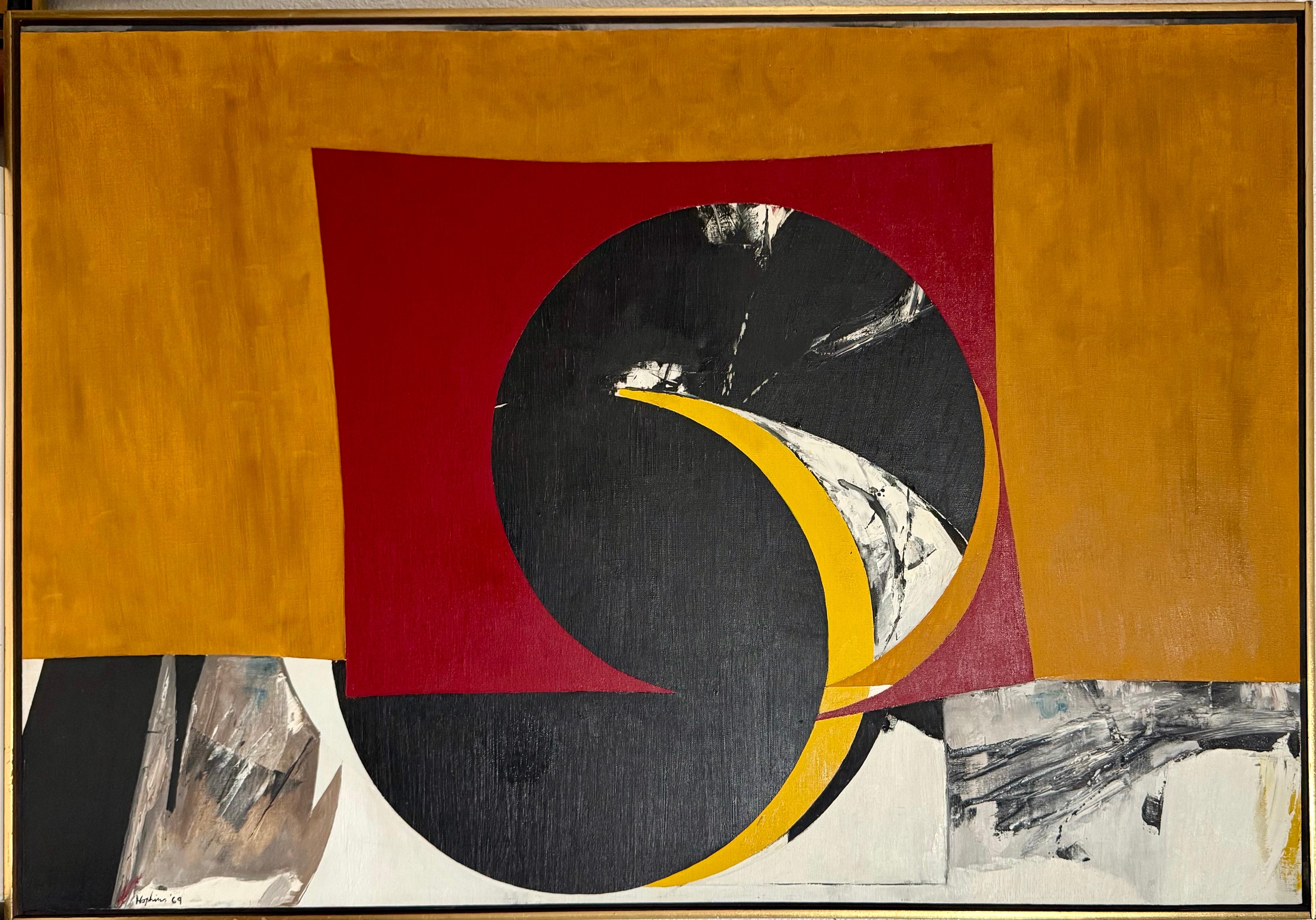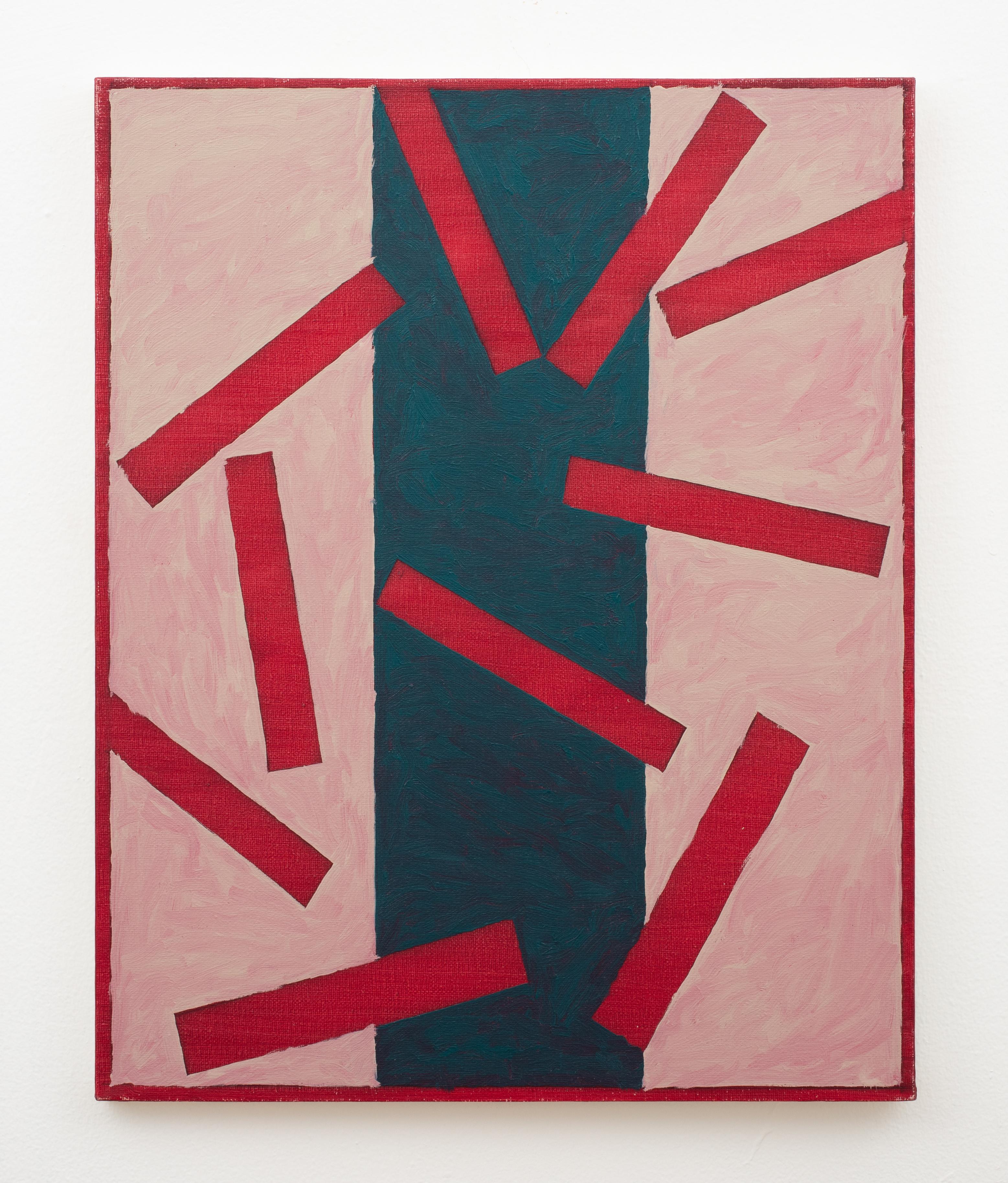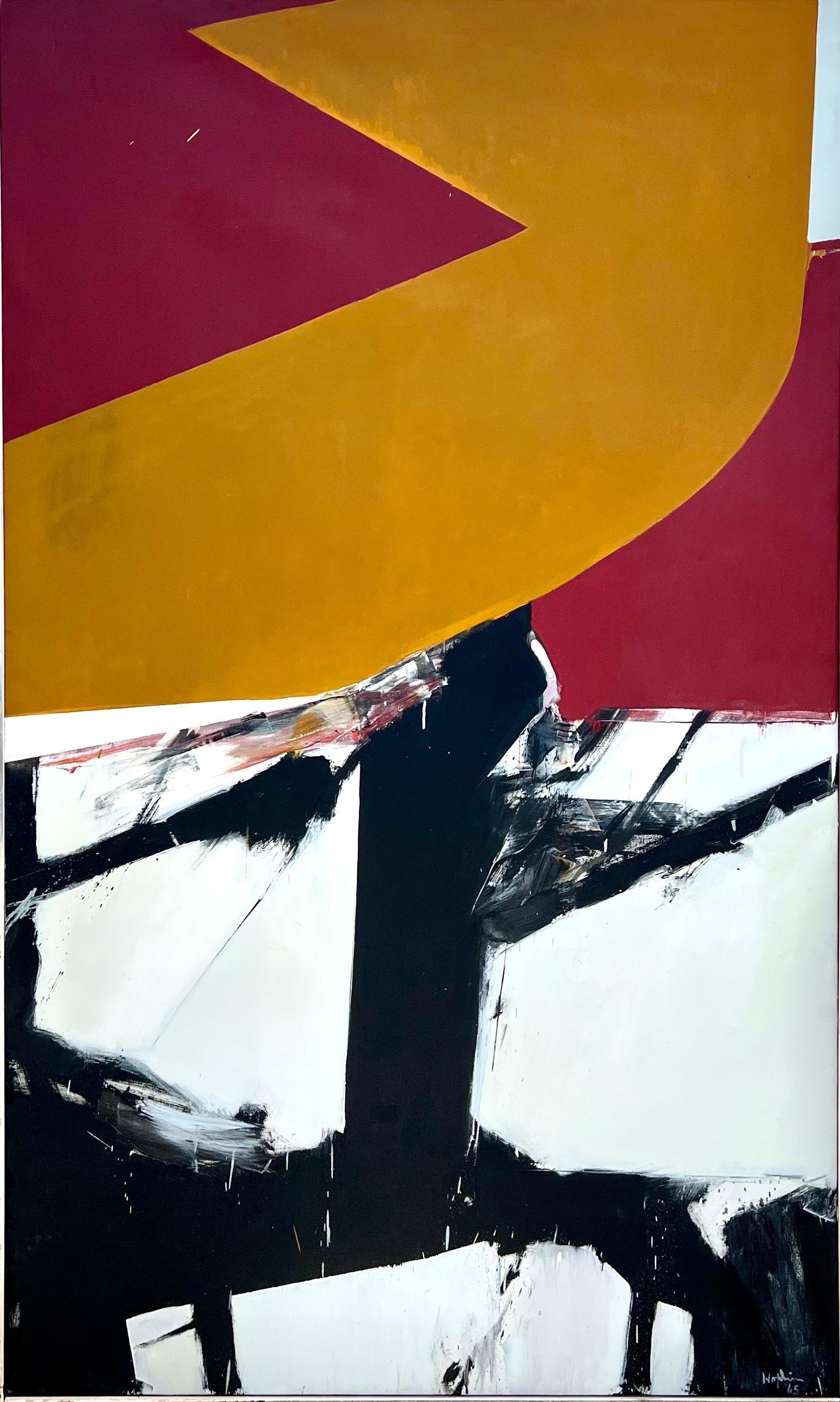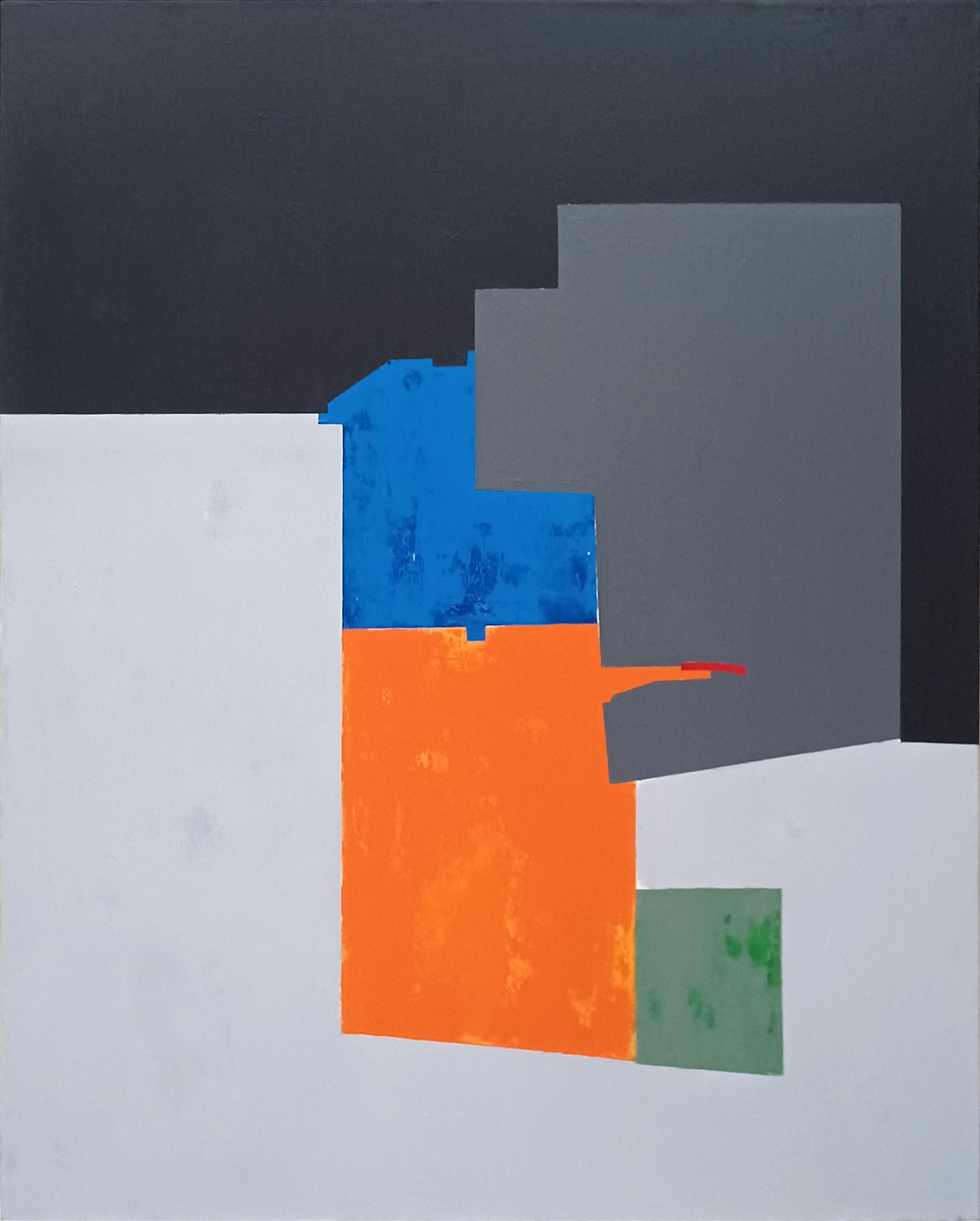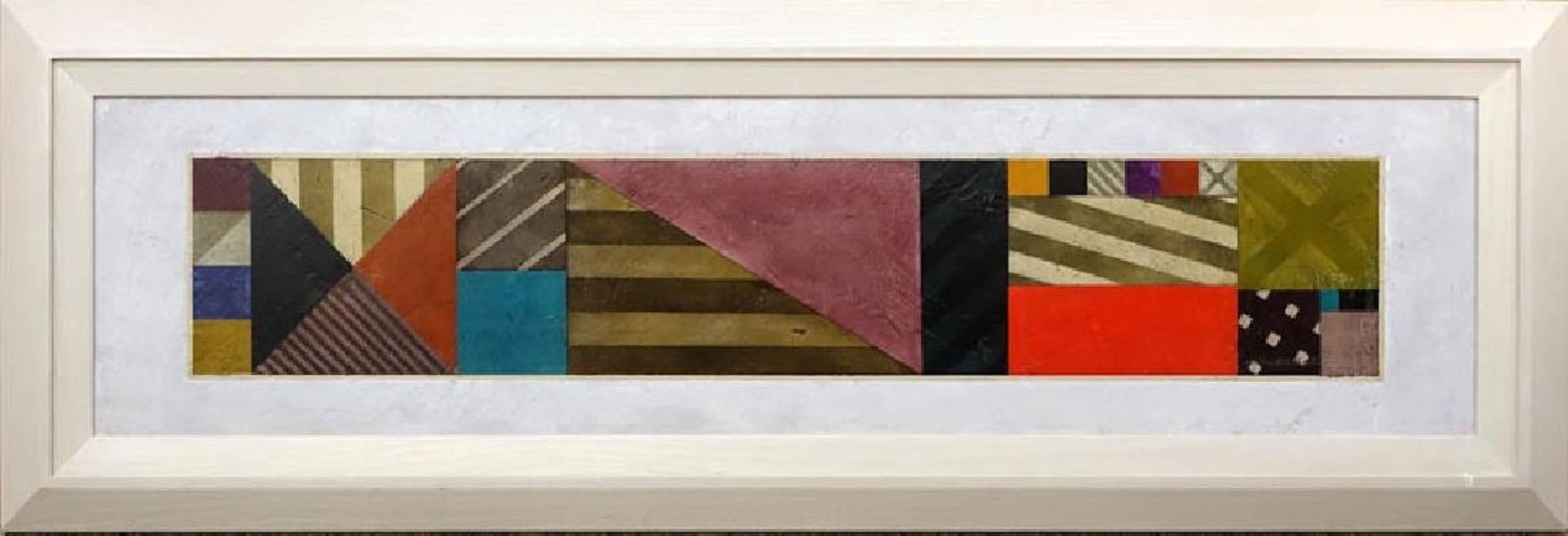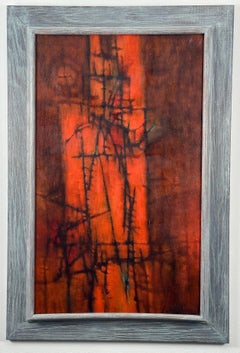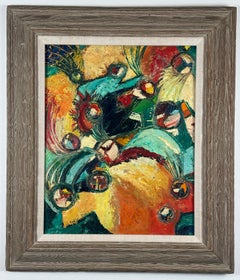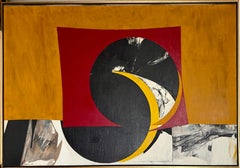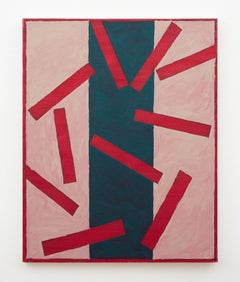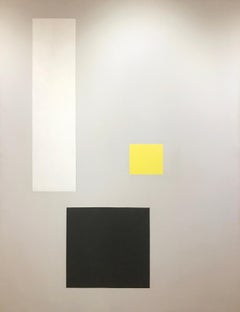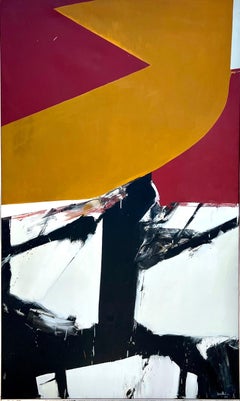Items Similar to Untitled (hard-edge abstract painting)
Want more images or videos?
Request additional images or videos from the seller
1 of 12
Budd HopkinsUntitled (hard-edge abstract painting)1968
1968
$6,000
£4,587.52
€5,251.18
CA$8,460.72
A$9,210.45
CHF 4,916.77
MX$111,191.22
NOK 61,822.21
SEK 57,459.68
DKK 39,218.70
About the Item
Budd Hopkins (1931-2011). Abstract, 1968. Oil on canvas, 30 x 52 inches; 31 x 53 inches framed. Signed and dated lower margin. Provenance: Timothy Collins (1940-2017), Palo Alto, CA.
Biography:
Birth place: Wheeling, WV
Addresses: NYC
Profession: Painter
Studied: Oberlin College (B.A., 1953); Columbia Univ., 1953-54, with Meyer Schapiro.
Exhibited: WMAA, 1958-72 (5 annuals); Festival Two Worlds, Spoleto, Italy, 1958; “Young America,” WMAA, Baltimore Mus. Art, St. Louis Art Mus. & others, 1960; Allen Mem. Art Mus., 1957 (Three Young Americans); PAFA, 1964; Yale Univ. Art Gal., 1967 (Benjamin Collection); “Young New England Painters,” Ringling Mus. Art, Portland Mus. Art & Currier Gal., 1969; William Zierler Gal., NYC, 1970s
Member: Provincetown AA (hon. vice-pres., 1968-70).
Work: WMAA; Guggenheim Mus.; SFMA; Hirshhorn Coll., Wash., DC; Williams College Mus., MA. Commissions: oil painting, West Virginia State Humanities Council, 1972.
Comments: Hard-edge abstract minmalist painter active in Provincetown, MA, 1956-70s. Preferred media: oils, acrylics. Contributor: “First Person Singular,” Art Gallery April, 1972; co-auth., “Concept vs. Art Object,” Arts April, 1972. Teaching: docent, MoMA.
Born in 1931, he is a graduate of Linsly Military Institute (now Linsly School) in 1949 and Oberlin College in 1953. He first displayed artistic abilities when, as a child recovering from a long-term illness, he began to create sculptures of ships made out of modeling clay. But it wasn't until he arrive at Oberlin that he made a serious study of art.
He settled in New York after obtaining his degree and has had a residence there ever since. He and his wife, April Kingsley, and their daughter, Grace, divide their time between their home at Cape Cod, Mass., and that in New York City.
In his work, he travels widely. He has exhibited in England, Finland, Italy and Switzerland.
In 1963, Hopkins was selected by the Columbia Broadcasting System as one of the 15 painters featured in the network's first television special on American art. In 1958, Art News picked him as one of 12 Americans for exhibition in Spoleto, Italy, in the "Festival of Two Worlds."
His brilliance has won him a humber of fellowships and awards. In 1972, the West Virginia Arts and Humanities Council awarded him its Commission Prize. In 1976, he received the John Simon Guggenheim Fellowship for Painting and in '79 he received a fellowship from the National Endowment of the Arts. He also won a special project grant from the New York State Council on the Arts in 1982.
Hopkins' work has appeared in many exhibitions across the country and he is represented in many important private and corporate collections around the nation.
His art has been featured in the Metropolitan Museum of Art, Museum of Modern Art, Bronx Museum of Art, Brooklyn Museum, Whitney Museum, Corcoran Gallery, Guggenheim Museum, Queens Museum in New York, and the Public Library of New York.
Across the United States, it has been seen in the Smithsonian Institution and the Library Congress in Washington, D. C.; the Philadelphia Museum of Art, the Houston Museum of Fine Arts, and the San Francisco Museum, among others.
Universities and Colleges which have shown Hopkins paintings and sculpture include his alma mater, Oberlin; Princeton, Yale, Denison, Drew, Massachusetts Institute of Technology, DePauw, Williams, Brandeis, Middlebury, North Carolina, Michigan State, Reed, Bradford, Connecticut, Alabama, Bennington, and the City College of New York,
- Creator:Budd Hopkins (1931 - 2011, American)
- Creation Year:1968
- Dimensions:Height: 52 in (132.08 cm)Width: 71 in (180.34 cm)Depth: 1 in (2.54 cm)
- Medium:
- Movement & Style:
- Period:
- Condition:
- Gallery Location:Wilton Manors, FL
- Reference Number:1stDibs: LU245216710742
Budd Hopkins' paintings in the 1960s combined the precise, hard-edge geometric shapes he was enthralled with and drawn to as a child with gestural, atmospheric painting characteristic of second- and later-generation Abstract Expressionists. "I had come to understand that an abstract painting at its most powerful was a kind of aesthetic scrim behind which lurks a concealed, obsessive 'thing' or image of some kind, transformed, made palatable by the artist's mediating skills." Hopkins viewed collage as an artistic technique and a philosophical, aesthetic means of unifying a disjointed and fragmented world. He saw collage, the assemblage of fragments and varying points of view, in the poetry, painting, sculpture, music, architecture, and, especially, motion pictures of his day: "Consciously or unconsciously, contemporary artists work to create harmony from distinctly jarring material, forcing warring ideas, materials and spatial systems into a tense and perhaps arbitrary detente. Seen most broadly, the presence of the collage aesthetic is the sole defining quality of modernism in all the arts." Hopkins worked to achieve harmony, clarity and precision while maintaining a sense of mystery: "I like neither extreme in art wholeheartedly, neither the purified world of geometrical art nor the free, indulgent world of Expressionism." In 1963, Hopkins' work was included in American Painters, a film documentary of American artists and styles with commentary from Alfred Barr of the Museum of Modern Art, Thomas Hess of Art News Magazine, Sidney Janis, gallery director, and Harold Rosenberg, art critic. Later, Hopkins included abstracted figures in his sculptural pieces. While moving away from Abstract Expressionism, Hopkins retained in his work the use of intense colors and hard-edged forms. His works of the 1980s, including Temples and Guardians, featured these "sentinals" who were, according to Hopkins, "participating in a frozen ritual, fixed – absolutely – within a privileged space…" Though Hopkins denied any connection, some critics viewed these ritualistic pieces as an extension of Hopkins' fascination with alien beings. Hopkins viewed his sculpted guardians not as human per se, but as magical, fierce, noble robots of the unconscious. Hopkins exhibited his paintings and sculptures in museums, galleries such as Andre Zarre, Levis Fine Art and Poindexter (New York) and Jan Cicero (Chicago), and universities throughout the United States. Hopkins had a major retrospective exhibition at the Provincetown Art Association and Museum in the summer of 2017. The Whitney Museum, Washington Gallery of Modern Art, Metropolitan Museum of Art, Museum of Modern Art, Corcoran Gallery of Art, the British Museum, include Hopkins' work in their permanent collections.
About the Seller
4.9
Platinum Seller
Premium sellers with a 4.7+ rating and 24-hour response times
Established in 2007
1stDibs seller since 2015
440 sales on 1stDibs
Typical response time: 4 hours
- ShippingRetrieving quote...Shipping from: Wilton Manors, FL
- Return Policy
More From This Seller
View AllUntitled (Abstract Expressionist Painting)
By Jesse Redwin Bardin
Located in Wilton Manors, FL
Jesse Redwin Bardin (1923-1997). Untitled, ca. 1960.
Oil on canvas, 18 x 31 inches; 21.5 x 36.5 inches framed. Signed lower right.
Provenance: Private collection, Philadelphia; F...
Category
Mid-20th Century Abstract Expressionist Abstract Paintings
Materials
Canvas, Oil
Abstract Constructivist Composition
By Alexander Rodchenko
Located in Wilton Manors, FL
Constructivist abstract painting, ca. 1940
Oil on canvas, 20 x 24 inches.
Unframed, unsigned.
In all likelihood, the painting is American, not European or Russian.
Marking on ver...
Category
Mid-20th Century Abstract Geometric Abstract Paintings
Materials
Oil
Untitled (Abstract Expressionist Painting)
By Bertha Davis
Located in Wilton Manors, FL
Bertha G. Davis (1911-1997)
Untitled, ca. 1960's
Oil on cradled masonite panel.
16 x 20 inches; 24 x 28 inches framed.
Signed lower left. Artist estate stamp on verso.
Vintage custom wormy chestnut frame.
A painter of cityscapes, landscapes, and abstracts in Texas, Bertha G Davis was primarily a self-taught artist whose style was influenced by her early life experiences in pre-World War II Lithuania and later Mexico. Her style is expressionistic*, relying on color to denote her profound feelings. She works primarily in watercolor and acrylic with some mixed media*.
She is the daughter of Abraham and Dvora Germaize of Vilna, Lithuania and grew up in Jewish ghettos in Vilna, Alita, and Kovno. Davis was influenced by her father who was a decorative wood-worker and carpenter in Lithuania. The family of five daughters and a son escaped to Mexico City in the late 1920’s because of Jewish oppression. The images and emotions she experienced had no outlet.
She was known as a beauty, and at age 17 was named Jewish Miss Mexico, barely able to speak Spanish having just emigrated from Eastern Europe. Irving Davis, a merchant from Texas who had also come from Eastern Europe via Cuba, saw her at this event where she was crowned Jewish Miss Mexico, and three days later asked for her hand in marriage. They moved to a small town in Texas, raising a family.
Her daughter, Sylvia, was born when Davis was 20 and they were inseparable. As Sylvia became an actress, painter, and sculptor, Davis was amazed at the capacity for creativity. Davis didn’t begin her own artistic journey until she was 47, when her daughter Sylvia Caplan encouraged her to try. She was inspired by this daughter who gave her a drugstore palette of watercolors, paper and brushes and told her to “just try.” Davis did not put down her palette and brushes until her death in 1997.
Bertha G Davis was primarily self-taught but maintained a style oriented toward color and texture that reflected her strong feelings. Most of her early work was done while she lived in McAllen, Texas where she was known for her contribution to art and showed her work and the work of other artists at the Bertha Davis Gallery.
She studied with Stewart Van Orden, at Pan American College in 1960-61; and was a student at the Art Institute San Miguel Allende, Mexico, 1965. She was also a student of Harold Phenix...
Category
Mid-20th Century Abstract Expressionist Abstract Paintings
Materials
Masonite, Oil
$975 Sale Price
35% Off
Untitled (abstract expressionist mid-century modern painting)
By Joseph Fiore
Located in Wilton Manors, FL
Joseph Fiore (1928-2005) Untitled, ca. 1955. Oil on canvas, 18 x 24 inches.
Measuring 24 x 30 inches in custom modernist frame. Signed lower left. Excellent condition.
Joseph Albe...
Category
Mid-20th Century Abstract Expressionist Abstract Paintings
Materials
Canvas, Oil
$3,000 Sale Price
25% Off
Untitled Abstract Expressionist painting
By Desmond McLean
Located in Wilton Manors, FL
Desmond Mclean (1929-2015).
Untitled, ca. 1965
oil on canvas
16 x 20 inches; 18 x 22 inches in wood frame.
Born: Ireland
Studied: Heatherly School of Art, London; American Sc...
Category
Mid-20th Century Abstract Expressionist Mixed Media
Materials
Paper, Charcoal, Gouache, Color Pencil
Untitled Abstract Expressionist composition
By Eve Peri
Located in Wilton Manors, FL
Beautiful ca. 1955 oil painting by American artist, Eve Peri. Oil on illustration board, panel measures 10 x 15 inches; 15.75 x 20.75 inches framed. Signed lower left. Excellent condition.
Vintage...
Category
Mid-20th Century Abstract Abstract Paintings
Materials
Oil, Illustration Board
$975 Sale Price
35% Off
You May Also Like
Large Budd Hopkins Modernist Hard Edged Abstract Expressionist Oil Painting 1965
Located in Surfside, FL
Budd Hopkins, American (1931-2011)
'City Sun II',
1969
Oil painting on canvas.
Hand signed and dated lower left.
Verso: Artist, title, and year in pencil on stretcher. Dimensions: 36" H x 52" w. Frame: 37.25" h x 53.25" w.
Budd Hopkins was one of the leading proponents of the "hard-edge" abstract minimalist school of painting in the 1950s and 1960s, Budd Hopkins (born 1931) created works that show the strong influence of Jackson Pollock and other leading painters of the Abstract Expressionism movement. Hopkins' paintings are now in numerous major collections, including the San Francisco Museum of Art, the Guggenheim Museum in New York, and the Hirshhorn Collection in Washington, DC.
Recently, he has also been recognized for his research into the matter of UFOs and one of his books, "The Intruders", printed by Random House, was on the New York Times best-seller list and was the basis for a television show on CBS.
Born in 1931, he is a graduate of Linsly Military Institute (now Linsly School) in 1949 and Oberlin College in 1953. He first displayed artistic abilities when, as a child recovering from a long-term illness, he began to create sculptures of ships made out of modeling clay. But it wasn't until he arrive at Oberlin that he made a serious study of art. Later, Hopkins included abstracted figures in his sculptural pieces. While moving away from Abstract Expressionism, Hopkins retained in his work the use of intense colors and hard-edged forms. His works of the 1980s, including Temples and Guardians, featured these "sentinels" who were, according to Hopkins, "participating in a frozen ritual, fixed – absolutely – within a privileged space..." Though Hopkins denied any connection, some critics viewed these ritualistic pieces as an extension of Hopkins' fascination with alien beings. Hopkins viewed his sculpted guardians not as human per se, but as magical, fierce, noble robots of the unconscious.
He settled in New York after obtaining his degree and has had a residence there ever since. He and his wife, April Kingsley, and their daughter, Grace, divide their time between their home at Cape Cod, Mass., and that in New York City. In his work, he travels widely. He has exhibited in England, Finland, Italy and Switzerland.
In 1963, Hopkins was selected by the Columbia Broadcasting System as one of the 15 painters featured in the network's first television special on American art. In 1958, Art News picked him as one of 12 Americans for exhibition in Spoleto, Italy, in the "Festival of Two Worlds."
His brilliance has won him a number of fellowships and awards. In 1972, the West Virginia Arts and Humanities Council awarded him its Commission Prize. In 1976, he received the John Simon Guggenheim Fellowship for Painting and in '79 he received a fellowship from the National Endowment of the Arts. He also won a special project grant from the New York State Council on the Arts in 1982. He was friends with Robert Ryman and many of the other 10th street avant garde artists. He was an original member of March Gallery which showed Alice Baber, Elaine de Kooning, Mark di Suvero, Lester Johnson, Matsumi Kanemitsu.
His work was handled by Poindexter Gallery. (a major gallery founded in 1955 in New York City by Elinor Poindexter. The gallery specialized in sculpture, abstract, and figurative art and featured the works of such artists as Richard Diebenkorn, Jules Olitski, Nell Blaine, Al Held, Willem de Kooning, Franz Kline, Earl Kerkam, Milton Resnick and Robert De Niro, among others.
His art has been featured in the Metropolitan Museum of Art, Museum of Modern Art, Bronx Museum of Art, Brooklyn Museum, Whitney Museum, Corcoran Gallery, Guggenheim Museum, Queens Museum in New York, and the Public Library of New York. He was included in Young America 1960: Thirty American Painters Under Thirty-Six buy Lloyd Goodrich at the Whitney Museum of American Art in NYC. Artists included: Sonia Gechtoff, Edward Giobbi, Ron Gorchov, James Harvey, Budd Hopkins, Wolf Kahn, Alex Katz, Robert Natkin, Rudy Pozzatti, Dean Richardson, Frank Roth, William Wiley, and Noriko Yamamoto...
Category
1960s Abstract Expressionist Abstract Paintings
Materials
Canvas, Oil
Untitled
By John Havens Thornton
Located in Brooklyn, NY
John Havens Thornton, Untitled, 2008 — oil on canvas
A lively folded structure rises from a pale field, its interlocking planes switching between electric turquoise, rust, umber, an...
Category
Early 2000s Abstract Geometric Interior Paintings
Materials
Canvas, Oil
Untitled (First Theme)
By Burgoyne Diller
Located in Lambertville, NJ
Ashley John is proud to offer this artwork by:
Burgoyne A Diller (1906 - 1965)
Recognized as the first American painter to embrace the tenets of Neo-Plasticism, Burgoyne Diller mad...
Category
20th Century Abstract Abstract Paintings
Materials
Canvas, Oil
Large Budd Hopkins Modernist Hard Edged Abstract Expressionist Oil Painting 1965
Located in Surfside, FL
Budd Hopkins, American (1931-2011)
Strike Red
Oil on canvas, 1965, signed 'Hopkins' and dated lower right.
Dimensions: 85 x81 in., 86 x 52 in. with frame.
Provenance: bears partial label remnant verso from Poindexter Gallery. (a major gallery founded in 1955 in New York City by Elinor Poindexter. The gallery specialized in sculpture, abstract, and figurative art and featured the works of such artists as Richard Diebenkorn, Jules Olitski, Nell Blaine, Al Held, Willem de Kooning, Franz Kline, Earl Kerkam, Milton Resnick and Robert De Niro, among others.
Budd Hopkins was one of the leading proponents of the "hard-edge" abstract minimalist school of painting in the 1950s and 1960s, Budd Hopkins (born 1931) created works that show the strong influence of Jackson Pollock and other leading painters of the Abstract Expressionism movement. Hopkins' paintings are now in numerous major collections, including the San Francisco Museum of Art, the Guggenheim Museum in New York, and the Hirshhorn Collection in Washington, DC.
Recently, he has also been recognized for his research into the matter of UFOs and one of his books, "The Intruders", printed by Random House, was on the New York Times best-seller list and was the basis for a television show on CBS.
Born in 1931, he is a graduate of Linsly Military Institute (now Linsly School) in 1949 and Oberlin College in 1953. He first displayed artistic abilities when, as a child recovering from a long-term illness, he began to create sculptures of ships made out of modeling clay. But it wasn't until he arrive at Oberlin that he made a serious study of art. Later, Hopkins included abstracted figures in his sculptural pieces. While moving away from Abstract Expressionism, Hopkins retained in his work the use of intense colors and hard-edged forms. His works of the 1980s, including Temples and Guardians, featured these "sentinels" who were, according to Hopkins, "participating in a frozen ritual, fixed – absolutely – within a privileged space..." Though Hopkins denied any connection, some critics viewed these ritualistic pieces as an extension of Hopkins' fascination with alien beings. Hopkins viewed his sculpted guardians not as human per se, but as magical, fierce, noble robots of the unconscious.
He settled in New York after obtaining his degree and has had a residence there ever since. He and his wife, April Kingsley, and their daughter, Grace, divide their time between their home at Cape Cod, Mass., and that in New York City. In his work, he travels widely. He has exhibited in England, Finland, Italy and Switzerland.
In 1963, Hopkins was selected by the Columbia Broadcasting System as one of the 15 painters featured in the network's first television special on American art. In 1958, Art News picked him as one of 12 Americans for exhibition in Spoleto, Italy, in the "Festival of Two Worlds."
His brilliance has won him a number of fellowships and awards. In 1972, the West Virginia Arts and Humanities Council awarded him its Commission Prize. In 1976, he received the John Simon Guggenheim Fellowship for Painting and in '79 he received a fellowship from the National Endowment of the Arts. He also won a special project grant from the New York State Council on the Arts in 1982. He was friends with Robert Ryman and many of the other 10th street avant garde artists. He was an original member of March Gallery which showed Alice Baber, Elaine de Kooning, Mark di Suvero, Lester Johnson, Matsumi Kanemitsu.
His art has been featured in the Metropolitan Museum of Art, Museum of Modern Art, Bronx Museum of Art, Brooklyn Museum, Whitney Museum, Corcoran Gallery, Guggenheim Museum, Queens Museum in New York, and the Public Library of New York. He was included in Young America 1960: Thirty American Painters Under Thirty-Six buy Lloyd Goodrich at the Whitney Museum of American Art in NYC. Artists included: Sonia Gechtoff, Edward Giobbi, Ron Gorchov, James Harvey, Budd Hopkins, Wolf Kahn, Alex Katz, Robert Natkin, Rudy Pozzatti, Dean Richardson...
Category
1960s Abstract Expressionist Abstract Paintings
Materials
Paint
Suggestion A, Painting, Acrylic on Canvas
Located in Yardley, PA
Acrylic on canvas 81x65x2 cm. Abstraction with minimal geometric forms Ready to hang. No framing required In this work of art, I have used acrylic to explore the relationship betw...
Category
2010s Abstract Abstract Paintings
Materials
Acrylic
Large Modernist Abstract Painting (1of 2 available)
By Gregg Robinson
Located in Surfside, FL
Gregg Robinson, American (born 1948) "Cipher Bar 20" Oil on Canvasboard Panel. Artist signed, title and dated 1990 far right. Very minor rubbing to paint. Panel measures 15-1/4" H x 63-1/2" W, frame measures 24-1/4" H x 72-1/4"
GREGG ROBINSON
The universe of visual art encompasses a huge spectrum of motivation and means of expression. Examples range from the most syrupy sentimentality to extremes of moral and intellectual confrontation. For me, the creative process is, on the simplest level, an aesthetic puzzle. Elements of the puzzle include contrast, color, visual texture, graphic pattern, and in some recent work, a simple cryptic symbolism.
I have never been particularly interested in lyric or pictorial content, and though some of my work does contain undeniable spatial illusion, even that tends to be a by-product rather than a goal of the primary pursuit: the balance of light and dark, pure color and organic neutrals, energy and calm, strong pattern and subtle field. Having grown up in an environment of contemporary architecture, I have always valued the classic modern synthesis of form and function exemplified by the Bauhaus movement of the early 20th century. Hence, the simplest solutions are often the most satisfying. Obviously, the modernist ideal of efficiency in form and function requires that method of execution be as well adapted to the aesthetic goal as the visual language itself.
The media before you is the result of many years of experimentation that came to its current form in early 1992. I work with dry pigment over a plaster surface. My tools are broad knives, sponges, rags and masking. The finish is a high gloss alkyd resin.
CORPORATE COLLECTIONS:
Allstate Insurance
NBC Productions
Alaska...
Category
1990s Contemporary Abstract Paintings
Materials
Canvas, Mixed Media, Oil, Board
